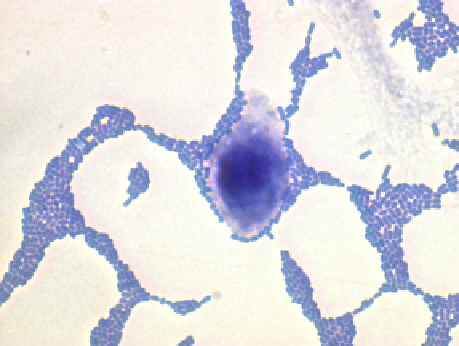Biology Reference
In-Depth Information
Chile (
Nataro et al., 1987
). Shortly thereafter, EAEC was associated with per-
sistent diarrhea among children in three studies (
Bhan et al., 1989a
,
b
;
Cravioto
et al., 1991
).
EAEC is a pathotype of DEC defined as
E. coli
that do not secrete the
heat-stable (ST) or heat-labile (LT) toxins of enterotoxigenic
Escherichia coli
(ETEC), and which manifest a characteristic aggregative or 'stacked brick' pat-
tern (AA) of adherence to HEp2-cells in culture (
Figure 8.1
).
Rapid developments in molecular microbiology lead to novel definitions for
EAEC, yet the gold standard is the adhesion pattern on cell monolayers.
Typical EAEC applies to EAEC strains possessing the AggR regulon
(described below). Typical EAEC strains have been linked to acute diarrhea
(
Sarantuya et al., 2004
;
Huang et al., 2006
). However, atypical EAEC lack the
AggR regulon and are not reliably associated with diarrhea (Nataro, 2005).
Since the original description, EAEC has emerged as an important pathogen
in several clinical scenarios, including travelers' diarrhea (
Adachi et al., 1999
,
2001
,
2002
;
Glandt et al., 1999
;
Tompkins et al., 1999
), endemic pediatric diar-
rhea among children in developed countries (
Tompkins et al., 1999
), and devel-
oping countries (
Okeke et al., 2000a
), as well as persistent diarrhea amongst
HIV-infected patients (
Wanke et al., 1998a
,
b
;
Durrer et al., 2000
;
Mossoro
et al., 2002
;
Gassama-Sow et al., 2004
). A meta-analysis by
Huang et al. (2006)
showed that EAEC is a cause of acute diarrheal illness among different sub-
populations in both developing and industrialized regions.
EPIDEMIOLOGY
EAEC epidemiology is poorly understood. There is no evidence for an animal
reservoir of the bacterium (
Huang et al., 2004a
). Foodborne outbreaks have
FIGURE 8.1
Characteristic aggregative or 'stacked brick' pattern of adherence (AA) to HEp2-
cells in culture by EAEC prototype strain 042. Photograph by Nadia Boisen.


Search WWH ::

Custom Search